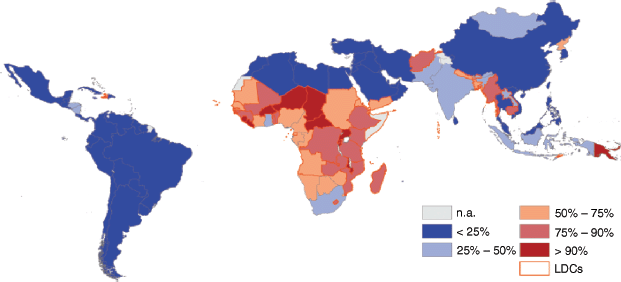1.6 Energy Challenges at the Base of the Economic Pyramid
Whereas the main challenge in Western and emerging economies is to reduce energy and adapt to sustainable energy conversions, a great part of humankind struggles with a maybe even bigger problem, because it lacks access to modern energy services. Globally 1.5 billion people have no access to electricity; of them, 80% live in rural areas (UNDP/WHO, 2009). The majority of these people live in Southeast Asia and Sub-Saharan Africa (Figure 1.6.1), where the penetration grade of the electricity grid is low. The development of successful energy solutions for this part of world population is a challenge because of their poverty, often described by the term base of the pyramid (BoP) (Prahalad and Hammon, 2002; Prahalad and Hart, 2002) and identified as the 4 billion people living on an income of US $3.00 or less per day and the more than 1 billion people living on less than US $1.00 a day (World Bank, 2005), This BoP part of the world's population struggles with poverty and is characterized by a lack of access to basic needs as education, health care, and infrastructure, such as clean water supply and clean, safe, and reliable energy.
Figure 1.6.1 Share of the population without access to electricity (UNDP/WHO, 2009)

As mentioned in this chapter, 1.5 billion people don't have access to electricity but, even once connected to the grid, they often lack stable electricity supply, since rolling blackouts, ranging from 15 minutes to 6 hours a day, are common in many regions. Consequently, in these situations they also have to rely on diesel generators for productive uses and low-grade lighting sources such as candles, kerosene lanterns, and gas lamps to provide light at night. Not only is access to electricity an energy challenge for the BoP population, but also cooking and heating are causing issues. In rural regions of emerging and developing countries, 2.7 billion people cook on traditional stoves fueled by wood, dung, or other biomass resources (Aron et al., 2009; Gradl and Knoblauch, 2011); this causes health problems due to fumes, and accelerated deforestation due to unsustainable harvesting of biomass and wood collection, which is also known to be extremely time consuming.
As such access to clean, affordable, and reliable energy is a fundamental driver of economic growth, environmental sustainability, and social development (Gradl and Knoblauch, 2011). For example, light is one of these basic needs: It is required for education, improves the security of communities, and advances productivity (Gooijer et al., 2008; Ramani and Heijndermans, 2003). Also electricity for communication (radio, television, and telephone), health care, and productive uses can be directly translated into benefits in terms of poverty reduction, development, and improved health.
In addition to lack of access to energy and the social and health problems connected to this, there is the so-called poverty–BoP penalty. This refers to the fact that poor people have to spend more than wealthier ones on the same energy product or service. BoP markets pay among the world's highest unit costs – and get some of the world's poorest quality energy (ESMAP, 2003). On average, BoP households spend about 10–15% of their income on energy (Guesalaga and Marshall, 2008; Nehme, 2007).
In general the demand for electricity in BoP markets in developing countries is growing. In addition to satisfying their basic needs of lighting, heating, and preparing and preserving food, demand grows for comfort and entertainment applications. Therefore, it is useful to develop efficient and affordable energy solutions in the form of products and services. As such, an important design challenge is to generate energy innovations targeted at the world's emerging and developing economies.
